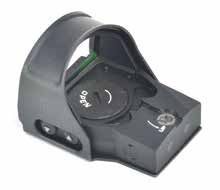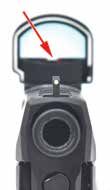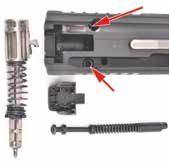The secret to shooting a handgun correctly has been boiled down to three words — Front Sight, Press. Anyone can line up the sights correctly. Anyone can activate a trigger. But can you line up the sights and then activate the trigger so that the alignment of the sights is not disturbed until the bullet leaves the muzzle? Then, add in the complicating factor that when the human mind feels the need to go fast, it wants you to look at the target, not the front sight. Stress does interesting things to your ability and your willingness to put your focus on the front sight. So does age. The military recognized this and started experimenting with the red dot–sight concept around 1970. Those concepts have been developed, tested, and accepted to the point where they are now standard equipment for almost everyone who carries a rifle in battle.
Those same principles work for shooters who feel the need for speed with a pistol, whether for self-defense, competition, or hunting. When using a red dot, keep both eyes open, look through the view-port, focus on the target, and superpose the red dot on the point of aim. That “activate the trigger smoothly” thing still comes up, but a red dot greatly simplifies aiming.

In the March 2020 issue, we provided a look at four modern everyday-carry (EDC) pistols with slide-mounted red dots. We compared accuracy and times required for various drills between the pistols and added in a comparison of some drills without the optics. The pistols that were red-dot equipped showed much higher scores than those without. Our methodology in that test was to use multiple pistols with the same or a very similar optic (Shield RMSc and SMSc). After publication, one of our readers contacted us and requested that, next time, we test red dots instead of the pistols. With that goal in mind, we selected a SIG Sauer X5 9mm Luger ($999) – currently one of the hottest pistols for the United States Practical Shooting Association’s (USPSA.org) Carry Optics division — as the test bed, along with a selection of red-dot sights, that would be appropriate for competition, hunting, or self-defense. Sights chosen were the Vortex Razor RZR-2003, $500; the Trijicon SRO SRO2-C-2500002, $750; the SIG Sauer Romeo 1PRO SOP1P101, $440; and the Crimson Trace CTS-1250 01-00560, $259.
How We Tested
We used a different testing routine than normal for this group. First, we did the testing with a single pistol with a single optic mounted over an extended period of time. We sighted in each red dot in turn, then shot them for groups at American Shooting Centers in west Houston. We shot the pistol/optic combo in practice for about a month, then finished everything off with a USPSA match.

Our biggest challenge/concern with the red dots has been mating them to the pistol. Rifles are well known for needing specific mounts for a specific model. We’re not sure why, but we never considered that before commencing this test, and we had issues. We needed an adapter to mount everything to the SIG X5. Even the SIG Romeo1Pro didn’t fit the SIG X5 without an adapter. Also, we found out the hard way that a SIG X5 and a SIG X5 Legion use different adapters! That required some careful work with a flat file.
We used Springer Precision (SpringerPrecision.com) for our adapter plates. Springer provided quick service and some great tech support, but we still had to improvise then find some extra 6-48 screws online. C&H Precision Weapons (chpws.com) also offers some adapters. The easy solution might be to look for a sight with the Docter pattern. Perhaps the manufacturers could post a list online of what adapters worked with which pistols? Could a more universal mount be created, as with a Picatinny rail? All things considered, we were impressed. We remember the early red dots when they were introduced to USPSA competitions in the late 1980s. What we tested here are light years ahead of those. To confirm our trust in this technology, our personal EDC, home defense, and competition pistols all mount good red dots.
We used the same Remington 115-grain 9mm ammo for all shooting tests. Here’s what we found:
Gun Tests Grade: A-
$440
The SIG Romeo1Pro red dot is available with 3- or 6-MOA dots, and we chose the larger for these closer-range pistol tests. The Romeo1Pro is covered via their Electro-Optics Infinite Guarantee, and somewhere in there the Electronic Component Limited 5-Year warranty takes over. We do know we once dropped a SIG red dot on the concrete, thereby rendering it hors de combat. It was our fault, and as truthful over-the-counter consumers, we told them that when we called them about it. They sent us another, quickly.
| Weight | 1.0 oz. |
| Length | 1.8 in. |
| Width | 1.2 in. |
| Dot Size | 6 MOA |
| Height Above Slide | 1.20 in. |
| Sight Window | Oval , 1.12 in. wide x 0.70 in. tall |
| Mount Type | Converted Springer Precision/X5 Legion |
| Battery Type | CR1632 |
| Battery Change | Top, slotted cover to unscrew |
| Estimated Battery Life | ~20,000 hours |
| Control Location | Left side |
| Warranty | Electro-optic infinite guarantee |
| Telephone | (603) 610-3000 |
| Website | SIGSauer.com |
| Made In | Assembled in Philippines |

The 1Pro also comes with an aircraft-grade-aluminum CNC housing. Whether for competition or self-defense, we like overbuilt. Should anyone else be as paranoid about red-dot failure as we are, the rear deck of the Romeo1Pro dot has a small, longitudinal channel that could serve as an emergency rear sight. The 1Pro even has SIG’s Truhold Lockless Zeroing System, which uses twin adjustment springs designed to help the unit take the beating and G-forces meted out by a handgun slide and stay zeroed.
The 1Pro has 12 brightness settings — ten daylight and two night modes. Estimated battery life is more than 20,000 hours. That is aided by MOTAC (Motion Activated Illumination System) that turns on as soon as it senses motion and powers down when left still for about 2 minutes. When the sight is moved, it turns back on powered at the last brightness setting. If all that worries you, the MOTAC can be turned off. Feel your inner SEAL kicking in? The 1Pro is IPX-7 rated for water immersion up to 1 meter.
Our Team Said: We liked the crisp, round 6-MOA dot and the protective metal hood. We also liked the wide field of view.

























